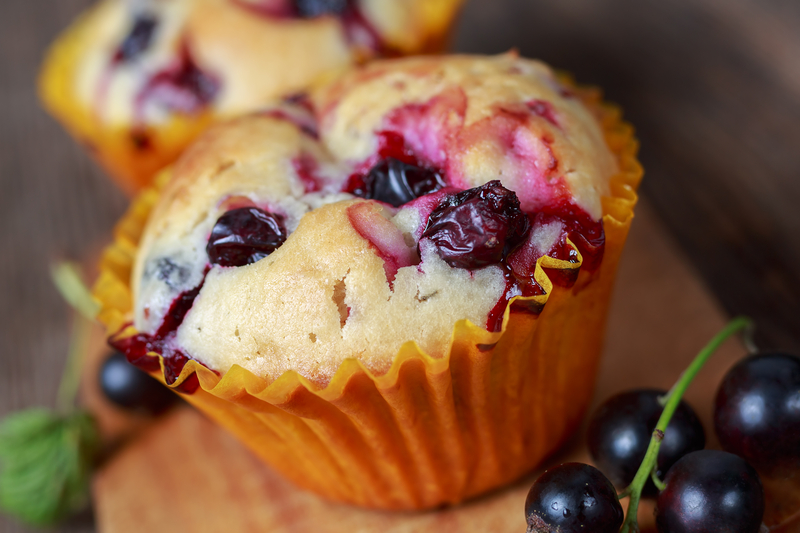 Muffins, those delightful, portable treats that often grace our breakfast tables or accompany our afternoon teas, come in a variety of flavors, shapes, and sizes.
Muffins, those delightful, portable treats that often grace our breakfast tables or accompany our afternoon teas, come in a variety of flavors, shapes, and sizes.
However, not many are aware that there are two distinct types of muffins, each with its unique characteristics and culinary history.
In this exploration, we delve into the world of muffins, uncovering the secrets behind the two main categories that have captured the taste buds of people worldwide.
1.The Classic American Muffin
 The American muffin, also known as the quick bread muffin, is the more commonly recognized type in many households.
The American muffin, also known as the quick bread muffin, is the more commonly recognized type in many households.
The humble muffin has a history that spans centuries, with its origins traced back to the British Isles.
The word “muffin” is thought to have originated from the Old French word “moufflet,” which referred to a soft bread.
Initially, English muffins were flat, yeast-leavened bread, and they gained popularity in the 18th century.
However, the transformation of the muffin into the domed, sweet, and cake-like treat we know today is largely attributed to American innovation in the 19th century.
The American muffin, distinct from its English counterpart, evolved into a lighter, sweeter version that incorporated baking powder as a leavening agent.
In the late 19th and early 20th centuries, muffins became a common street food in America, particularly in cities like New York.
Street vendors would peddle freshly baked muffins, serving them warm and enticing passersby with their delightful aroma.
The muffin’s popularity continued to soar in the mid-20th century, thanks in part to the convenience of pre-packaged muffin mixes.
Home bakers could easily whip up a batch of muffins by just adding a few ingredients to the mix.
With time, the muffin diversified, and bakers began experimenting with various flavors and mix-ins, contributing to the vast array of muffin options we have today.
From classic blueberry and chocolate chip to more exotic combinations like pumpkin spice and banana nut, the muffin has truly become a canvas for culinary creativity.
Whether enjoyed as a quick breakfast, a delightful snack, or a sweet treat with a cup of coffee, the evolution of the muffin from its early flat, yeast-leavened form to the modern, fluffy, and flavorful concoctions is a testament to the adaptability and innovation in the world of baking.
2.The English Muffin
 The English muffin has a long history that dates back to the 10th or 11th century in England.
The English muffin has a long history that dates back to the 10th or 11th century in England.
Initially, it was a flatbread cooked on a griddle.
This early version of the English muffin was likely made with a mixture of wheat and rye.
The English muffin, as we know it today, underwent a transformation when it made its way to the United States.
Samuel Bath Thomas, an Englishman, is credited with popularizing the muffin in the U.S.
In the late 1800s, Thomas opened a bakery in New York City and began selling his version of the English muffin, which was larger and thicker than the traditional English flatbread.
Thomas’ English Muffins became a staple breakfast item and gained widespread popularity.
English muffins are typically round, flat, and relatively small compared to other types of bread.
They have a porous texture, which is perfect for absorbing butter and other spreads.
What sets them apart is their method of cooking – they are griddled or cooked on a hot surface, often resulting in a slightly crispy exterior and a soft, chewy interior.
English muffins are commonly split in half and toasted before being served.
This toasting brings out their unique texture and allows for easy spreading of butter, jam, or other toppings.
English muffins are popularly used as a base for eggs Benedict, breakfast sandwiches, or simply enjoyed with butter or cream cheese.
While the traditional English muffin is plain, many variations have emerged over time.
There are now whole wheat, multigrain, and flavored English muffins available.
These can include ingredients like raisins, cranberries, or nuts, adding extra layers of flavor to this classic bread.
The English muffin’s journey from its humble origins in England to its prominent place on breakfast tables around the world is a testament to the way food evolves and adapts to different cultures and tastes over time.
Bottom Line – What are the Two Types of Muffins?
 In conclusion, the world of muffins is a diverse and flavorful one, offering two main categories—the American muffin and the English muffin—each with its distinctive characteristics and culinary heritage.
In conclusion, the world of muffins is a diverse and flavorful one, offering two main categories—the American muffin and the English muffin—each with its distinctive characteristics and culinary heritage.
Whether you find yourself savoring a sweet and moist American blueberry muffin or indulging in the chewy and versatile English muffin, one thing is certain: muffins, in all their forms, have become a beloved treat that transcends borders and brings joy to breakfast tables around the globe.


